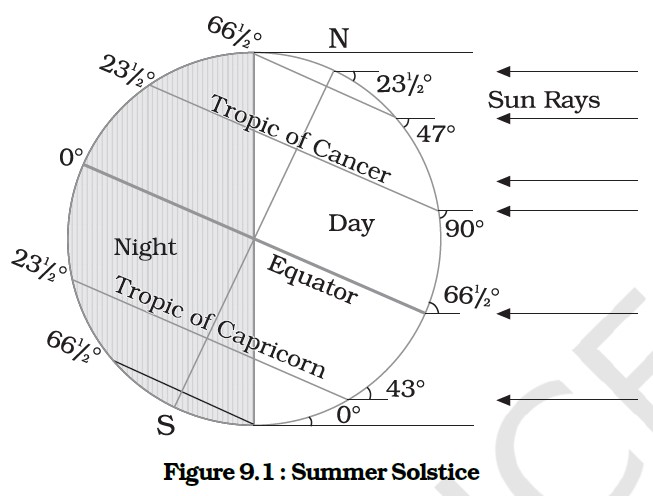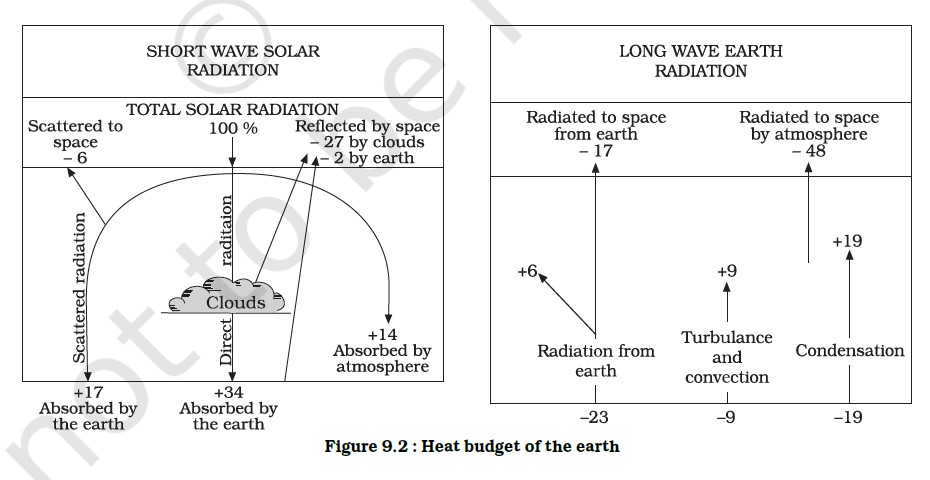SOLAR RADIATION, HEAT BALANCE AND TEMPERATURE
We feel air when it is in motion.
wind - air in motion is called wind
atmosphere - the earth is surrounded by air all around. This envelop of air is atmosphere.
- composed of numerous gases to support life over the earth's surface.
Note:- The earth receives almost all of its energy from the sun.
the earth in turn radiates back the energy received from the sun.
as a result the earth neither warms up nor does it get cooled over period of time.
the amount of heat received by different parts of the earth is not the same.
this variation of heat causes pressure differences in the atmosphere.
transfer of heat from one region to the other by winds.
Q. Process of heating and cooling of atmosphere
Q. Temperature distribution over earth's surface
Solar Radiation
The earth's surface receives most of its energy in short wavelengths.
The energy received by the earth is known as incoming solar radiation which in short is termed as insolation.
earth is geoid resembling a sphere -> Sun's rays fall on it obliquely at the top of the atmosphere --> earth intercepts a very small portion of the
sun's energy.
Average energy received by earth at the top if its atmosphere from Sun = 1.94 calories per sq. cm. per minute
Solar output received at the top of the atmosphere varies slightly in a year due to the variations in the distance between the earth and the sun.
earth is farthest from the sun = 152 million km [ on 4th July ] { this position of the earth is called aphelion }
earth is nearest to the sun = 147 million km [ 3rd January ] { this position of the earth is called perihelion. }
Annual insolation received on 3rd Jan > amount received on 4th July
Affect of variation in solar radiation is masked by other factors like - distribution of land, and sea and the atmospheric circulation.
Hence, this variation in the solar output does not have great effect on daily weather changes on the surface of the earth.
Variability of Insolation at the Surface of the Earth
The amount and intensity of insolation vary during a day, in a season and in a year.
The factor that cause variations in insolation (solar output) are :-
- the rotation of earth on its axis;
- the angle of inclination of the sun’s rays;
- the length of the day;
- the transparency of the atmosphere; (less influence)
- the configuration of land in terms of its aspect. (less influence)
earth’s axis makes an angle of 66½ degree with the plane of its orbit round the sun has a greater influence on the amount of insolation received at different latitudes.
amount of insolation affected by the angle of inclination of the rays. -> depends on the latitude of the place. --> higher the latitude the less is the angle they make with the surface --> slanted sun rays
Note :- area covered by vertical rays < area covered by the slant rays.
more area is covered --> the energy gets distributed --> the net energy received per unit are decreases
slant rays are to pass through greater depth of the atmosphere --> more absorption, scattering, and diffusion

The Passage of Solar Radiation through the Atmosphere
The atmosphere is largely transparent to short wave solar radiation.
Within the troposphere water vapour, ozone and other gases absorb much of the near infrared radiation.
Very small suspended particles in troposphere --> scatter visible spectrum both to the space and towards the earth surface.
[this process adds color to the sky. ]
scattering of light within the atmosphere --> red colour of the rising and the setting sun and the blue colour of the sky
Spatial Distribution of Insolation at the Earth’s Surface
insolation received Tropical surface = 320 Watt / m2
insolation received Polar surface = 70 Watt/m2
Maximum insolation = Over subtropical deserts (cloudiness is the least)
Equator receives comparatively less insolation than the tropics.
Equatorial insolation < Tropical insolation
insolation at continent > insolation on ocean [ at sam latitude ]
insolation in winter < insolation in summer [ middle and higher latitudes ]
HEATING AND COOLING OF ATMOSPHERE
earth gets heated by the insolation --> it transmits the heat to the atmosphere layers near to the earth in long wave form
air in contact with the land gets heated slowly.
upper layers in contact with lower layers also get heated. [ heat conduction ]
Conduction takes place when two bodies of unequal temperature are in contact with one another, there is a flow of energy from the warmer
to cooler body
The transfer of heat continues until both the bodies attain the same temperature or the contact is broken.
The air in contact with the earth rises vertically on heating in the form of currents and further transmits the heat of the atmsphere. This process of vertical heating of the atmosphere is known as convection .
Note:- The convective transfer of energy is confined only to the troposphere.
The transfer of heat through horizontal movement of air is called advection.
Note:- Horizontal movement of the air is relatively more important than the vertical movement.
In middle latitudes, most of dirunal (day and night) variation in daily weather are caused by advection alone.
In tropical regions particularly in northern India during summer season local winds called ‘loo’ is the outcome of advection process.
Terrestrial Radiation
Insolation received by earth = short wave form and heats up earth's surface --> earth becomes a radiating body and radiates energy back into atmosphere in long wave form.
This process heats up atmosphere from below and it is known as terrestrial radiation.
the long wave radiation is absorbed by the atmospheric gases ( CO2, and the green house gases)
- Atmosphere is indirectly heated by the earth's radiation.
- atmosphere radiates and transmits heat to the space.
- heat received from sun is returned to space --> maintain constant temperature at earth's surface and in atmosphere.
Heat Budget of the Planet Earth
